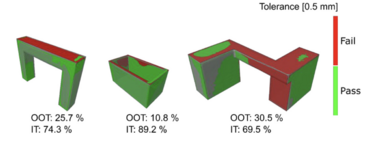Shahrooz Sadeghi Borujeni; Gursimran Singh Saluja; Vasily Ploshikhin
Rapid Prototyping Journal 29 (2023)
Purpose: This study aims at compensating for sintering deformation of components manufactured by metal binder jetting (MBJ) technology. Design/methodology/approach: In the present research, numerical simulations are used to predict sintering deformation. Subsequently, an algorithm is developed to counteract the deformations, and the compensated deformations are morphed into a CAD model for printing. Several test cases are designed, compensated and manufactured to evaluate the accuracy of the compensation calculations. A consistent accuracy measurement method is developed for both green and sintered parts. The final sintered parts are compared with the desired final shape, and the accuracy of the model is discussed. Furthermore, the effect of initial assumptions in the calculations, including green part densities, and green part dimensions on the final dimensional accuracy are studied. Findings: The proposed computational framework can compensate for the sintering deformations with acceptable accuracy, especially in the directions, for which the used material model has been calibrated. The precise assumption of green part density values is important for the accuracy of compensation calculations. For achieving tighter dimensional accuracy, green part dimensions should be incorporated into the computational framework. Originality/value: Several studies have already predicted sintering deformations using numerical methods for MBJ parts. However, very little research has been dedicated to the compensation of sintering deformations with numerical simulations, and to the best of the best of the authors' knowledge, no previous work has studied the effect of green part properties on dimensional accuracy of compensation calculations. This paper introduces a method to omit or minimize the trial-and-error experiments and leads to the manufacturing of dimensionally accurate geometries.
© 2022, Emerald Publishing Limited.


